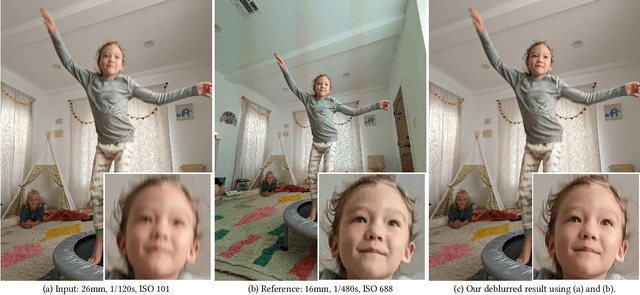Xiaotong Wu
Efficient Hybrid Zoom using Camera Fusion on Mobile Phones
Jan 02, 2024Abstract:DSLR cameras can achieve multiple zoom levels via shifting lens distances or swapping lens types. However, these techniques are not possible on smartphone devices due to space constraints. Most smartphone manufacturers adopt a hybrid zoom system: commonly a Wide (W) camera at a low zoom level and a Telephoto (T) camera at a high zoom level. To simulate zoom levels between W and T, these systems crop and digitally upsample images from W, leading to significant detail loss. In this paper, we propose an efficient system for hybrid zoom super-resolution on mobile devices, which captures a synchronous pair of W and T shots and leverages machine learning models to align and transfer details from T to W. We further develop an adaptive blending method that accounts for depth-of-field mismatches, scene occlusion, flow uncertainty, and alignment errors. To minimize the domain gap, we design a dual-phone camera rig to capture real-world inputs and ground-truths for supervised training. Our method generates a 12-megapixel image in 500ms on a mobile platform and compares favorably against state-of-the-art methods under extensive evaluation on real-world scenarios.
Robust retrieval of material chemical states in X-ray microspectroscopy
Aug 08, 2023Abstract:X-ray microspectroscopic techniques are essential for studying morphological and chemical changes in materials, providing high-resolution structural and spectroscopic information. However, its practical data analysis for reliably retrieving the chemical states remains a major obstacle to accelerating the fundamental understanding of materials in many research fields. In this work, we propose a novel data formulation model for X-ray microspectroscopy and develop a dedicated unmixing framework to solve this problem, which is robust to noise and spectral variability. Moreover, this framework is not limited to the analysis of two-state material chemistry, making it an effective alternative to conventional and widely-used methods. In addition, an alternative directional multiplier method with provable convergence is applied to obtain the solution efficiently. Our framework can accurately identify and characterize chemical states in complex and heterogeneous samples, even under challenging conditions such as low signal-to-noise ratios and overlapping spectral features. Extensive experimental results on simulated and real datasets demonstrate its effectiveness and reliability.
Face Deblurring using Dual Camera Fusion on Mobile Phones
Jul 23, 2022



Abstract:Motion blur of fast-moving subjects is a longstanding problem in photography and very common on mobile phones due to limited light collection efficiency, particularly in low-light conditions. While we have witnessed great progress in image deblurring in recent years, most methods require significant computational power and have limitations in processing high-resolution photos with severe local motions. To this end, we develop a novel face deblurring system based on the dual camera fusion technique for mobile phones. The system detects subject motion to dynamically enable a reference camera, e.g., ultrawide angle camera commonly available on recent premium phones, and captures an auxiliary photo with faster shutter settings. While the main shot is low noise but blurry, the reference shot is sharp but noisy. We learn ML models to align and fuse these two shots and output a clear photo without motion blur. Our algorithm runs efficiently on Google Pixel 6, which takes 463 ms overhead per shot. Our experiments demonstrate the advantage and robustness of our system against alternative single-image, multi-frame, face-specific, and video deblurring algorithms as well as commercial products. To the best of our knowledge, our work is the first mobile solution for face motion deblurring that works reliably and robustly over thousands of images in diverse motion and lighting conditions.
 Add to Chrome
Add to Chrome Add to Firefox
Add to Firefox Add to Edge
Add to Edge